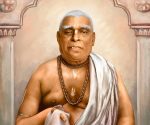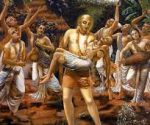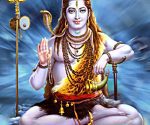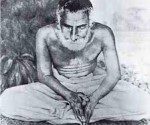How Deep is the Mountain?
Sri Srimad Bhaktivedanta Narayana Gosvami Maharaja


[This year, 2018, Srila Prabhupada (Bhaktivedanta Svami Maharaja’s) disappearance day is Noember 11th). In 1993, in Srila Prabhupada’s quarters at the ISKCON Juhu Beach temple in Bombay, Srila Bhaktivedanta Narayana Gosvami Maharaja spoke to an audience of 200 devotees. He had been requested at that time to share something of his relationship with Srila Prabhupada, to describe some of the services he rendered to Prabhupada in the past, and some of the services he has been rendering to him since his divine disappearance in 1977. The following is a transcription of his discourse:]
At the time of his divine departure from this world, Parama-pujyapada Srila Bhaktivedanta Svami Maharaja ordered me, “You should serve me in my taking samadhi.” He knew the meaning and significance of entering samadhi, and what should be done at that time.
Samadhi is a Sanskrit word consisting of the two syllables: sama-dhi. Sama means ‘the same’ and dhi means ‘intelligence.’ It means that the pure devotee who is departing from the vision of this world is entering the same level, same position, and same mood as the personal associates of his worshipful deity – with equal intelligence, equal beauty and equal qualities. He is serving properly according to his own svarupa (constitutional form). Srila Bhaktivedanta Svami Maharaja’s worshipful Deity is Srimati Radhika, and he is serving Her under the guidance of Her personal associates, the manjaris, headed by Sri Rupa Manjari.
He has preached about Lord Jagannatha-deva, Krsna-Balarama and other manifestations of Sri Sri Radha-Krsna, but from what I have understood from his writings, books, and personal darsanas, I am determined in the fact that his worshipful Deity is Srimati Radhika and he sees Sri Krsna as Radhika’s beloved.
His desire was to assist Srimati Radhika in Her desire to serve Sri Krsna in many various ways. He wanted at that time to be one with the mood of Her maidservants, and in that very place where She renders Her service. And he wanted my service at that time.
Sri Rupa Manjari serves Srimati Radhika when Radhika wants to meet Krsna. For example, in the night, when it is dark, she dresses Her in black clothes and ties Her ankle-bells so they will not make any sound. She gives so much uddipana (stimuli) to Srimati Radhika’s bhava. For example, at the time of dressing Her, she may put on a necklace which has as its centerpiece the syamantaka jewel. At that time she will say, “This jewel is the friend of Krsna’s Kaustubha jewel.” In this way she reminds Srimati Radhika of Her pastimes with Krsna, and Radhika bestows upon her all Her mercy.
If one can serve his Gurudeva in this mood, that is, in his Gurudeva’s service to Sri Rupa Manjari or Sri Radhika, this is the best service to Gurudeva.
I do not know why he gave me so much mercy that he chose me to give him some uddipana as he entered his samadhi. I performed this service by decorating him with tilaka and writing certain sacred mantras on his chest with sandalwood paste – indicating his services to his worshipful Deity, Srimati Radhika.
Just before his departure from this world, he requested me to sing Sri Rupa-Manjari-Pada* (See Endnote 1):
sri rupa manari-pada, sei more sampada,
sei mora bhajana-pujana
[“The lotus feet of Sri Rupa Manjari are my dearmost treasure. They are the topmost object of my worship and inner devotional practices.”]
sei more prana-dhana, sei more abharana
sei mora jivanera jivana
[“Her lotus feet are my most cherished wealth, more dear than my own life. They are the exquisite ornament of my life, and indeed are the very essence of my existence.”]
This is the best sankirtana of Sri Rupa Manjari, who can lead us to Radhika’s service. While I sang this I saw that his face was sometimes colored with one transcendental mood and sometimes with another. I had requested my brahmacari Sesaya to perform kirtana, and I personally performed this kirtana for him – just as I did for my Gurudeva. There were many similarities between my Guru Maharaja, Srila Bhaktiprajnana Kesava Gosvami Maharaja, and Srila Bhaktivedanta Svami Maharaja. I did what Srila Svami Maharaja ordered me to do for him and I feel so fortunate that he gave me this service; and I did the same for my Gurudeva at the time of his entering samadhi.
Just before his departure, Srila Svami Maharaja told me, “You should advise and help my disciples and all devotees connected with me.” I did not think I could help them at that time, for I considered them higher in rank than myself. I thought, “They have so much guru-nistha, faith in the lotus feet of their Gurudeva, and they are far more advanced than me. They know, better than I, the conclusive truths of the Krsna Consciousness philosophy (tattva-siddhanta). How can I help them?” But my siksa-guru gave some inspiration in my heart.
It is sometimes thought that Srila Svami Maharaja is only in sakhya-rasa – that is, in his constitutional spiritual form he is a cowherd friend of Krsna. When I hear this I experience pain in my heart, for the complete conception of him is that he is in madhurya-rasa.* [See endnote 2] Sakhya-rasa is included within madhurya-rasa, so sakhya-bhava is also within him, but he is in madhurya-rasa.* [See endnote 3]
There are two ways to see our Gurudeva, and an analogy can be given in this connection of the Himalayan Mountains. How high the Himalayas are is one thing – and how deep is another. We can somewhat see its height, but we cannot see what is hidden deep within the ground. We saw that Parama-pujyapada Srila Svami Maharaja collected a large number of disciples throughout the world in practically no time. We saw all varieties of his height. He loved everyone, and everyone knew, “He loves me so much;” and we saw this in our Guru Maharaja also.
How deep Sri Guru is, however, we cannot know. Srila Svami Maharaja used to sing Sri Gurvastakam with a profound mood and with tears in his eyes – in samadhi. He did not see who was looking at him and who was not, who was taking part and who was not. He was simply absorbed in singing and playing his karatalas.
The first to fourth verses of Sri Gurvastakam contain very high subject matter that we can realize and see, but there are two verses that we cannot:
sri-radhika-madhavayor apara-
madhurya-lila-guna-rupa-namnam
prati-ksanasvadana-lolupasya
vande guroh sri caranaravindam (5)
[“At every moment Sri Gurudeva is experiencing intense greed in his heart to taste the unlimited sweetness of the holy names, forms, qualities, and pastimes of Sri Sri Radha-Madhava in Vrndavana. I offer my prayers unto the lotus feet of Sri Gurudeva.”]
nikunja-yuno rati-keli-siddhyai
ya yalibhir yuktir apeksaniya
tatrati-daksyad ati-vallabhasya
vande guroh sri caranaravindam (6)
[“Sri Gurudeva is always present with the sakhis, planning the arrangements for the perfection of yugala-kisora’s amorous pastimes (rati-keli) within the kunjas of Vrndavana. Because he is so expert in making these tasteful arrangements for Their pleasure, he is very dear to Sri Radha and Krsna. I offer prayers unto the lotus feet of Sri Gurudeva.”]
Only one who is equal to his self-realized Guru can understand how deep he is. A kanistha-adhikari, neophyte, and a madhyama-adhikari, middle class devotee, cannot guess how deep are his feelings – what are the fathomless moods of krsna-prema and radha-prema in his heart. Without being an uttama-adhikari, a topmost pure devotee, one cannot understand.
Kanistha and madhyama-adhikari devotees can see his height, his aisvarya (opulence) – that he collected disciples and very quickly preached all over the world – but it is more valuable to see his depth. Ultimately he has not collected disciples to experience his height. He did that also, but he ultimately brought us only to give us his deep thoughts. This will take time, of course; it could take many births to realize something of this. When I see him and remember his orders, I become moved – knowing that he is engaged in nikunja-yuno rati-keli-siddhyai.
This is the main reason he came – to give this service. He came to obey the orders of Sri Caitanya Mahaprabhu, Sri Nityananda Prabhu and Sri Sri Radha and Krsna. But he had to spend a great deal of time laying the groundwork by preaching vaidhi-bhakti.
Srila Prabhupada Bhaktisiddhanta Sarasvati Thakura has said, “I came to give some valuable conceptions in raganuga-bhava – but I could not do so. Most of my life was spent in sweeping and cutting jungles.” Preaching is like this – and it is also so essential. Without preaching vaidhi-bhakti, that main thing cannot be given. Srila Sarasvati Thakura used to say that when the mayavada philosophy (becoming one in all respects with an impersonal God) is present, there can be no preaching of bhakti – so we will have to cut the jungles of atheism, mayavada, sahajiyism and other non-Vedic philosophies. We will have to spend time defeating their arguments.
I think that I have some very little role in this – to obey his orders. If I can give raganuga-bhakti in the hearts of devotees, I will see that I have fulfilled the orders he has given me. This is the best service I can render to his lotus feet. When you are situated in raganuga-bhakti, you will be able to factually see that his relationship with Sri Sri Radha and Krsna is in gopi-bhava. Then you can deeply think of his services to the Divine Couple in nikunja yuno rati keli siddhyai.
He used to sing daily:
jaya radha-madhava jaya kunja-bihari
gopi-jana-vallabha jaya giri-vara-dhari
yasoda-nandana, braja-jana-ranjana
yamuna-tira-vanacari
[“All glories to Sri Radha-Madhava! All glories to Kunja-bihari, who is the gopis dearmost beloved. He lifted Govardhana Hill and is the darling son of Yasoda-maiya. He wanders in the forests along the banks of the Yamuna, where He enjoys with the many different gopis in their own groves.”]
He has so much transcendental greed to serve Kunja-bihari. A sakha does not have the sentiments and thoughts of these exalted conceptions. The name Gopijana-vallabha in this song is also in our gopala-mantra. Srila Svami Maharaja desired to give the service performed by the gopis to Gopi-jana-vallabha, but he saw that there were only a few in this world who were qualified for this – the number could be counted on ones fingers. In order to gradually bring his audiences to a level wherein they could understand, he preached about Lord Jaganatha-deva and established deities of Sri Sita-Rama and Sri Krsna-Balarama.
The gopis have spoken about Rama-Krsna (Balarama is sometimes called Rama) in Srimad-Bhagavatam, but they were not actually referring to Rama meaning Balarama. They were indicating Ramaniya-Krsna; that is, Krsna, the enjoyer of Sri Radha. Their Rama is Krsna Himself. Qualified devotees – those who have received the mercy of their Gurudeva – will actually realize this; and others who desire to do so will realize it after some time.
If I can render this service to his lotus feet – to give an atom of the feelings of these exalted conceptions to his disciples and followers, I will render him the best service.
[*Endnote 1. He very much liked, “Hari Haraye Namah Krsna Yadava Namah,” “Jaya Radhe, Jaya Krsna, Jaya Vrndavana.” and “Sri Rupa Manjari-Pada,” and used to request me to sing these kirtanas. (UK Visit to Srila Prabhupada’s Room at Bhaktivedanta Manor 1996 May 17)
2. To explain the topmost quality of conjugal love, Srila Krsnadasa Kaviraja Gosvami gives the example of the material elements – sky, air, fire, water and earth. In the sky (space) there is the quality of sound. Similarly, in air there are the qualities of sound and touch. In fire, there are three qualities – sound, touch and form. In water there are four qualities—sound, touch, form and taste. Finally, in earth there are all five qualities – sound, touch, form, taste and also smell. Now, one can see that the quality of the sky is in all – namely in air, fire, water and earth. In earth we can find all the qualities of material nature. The same can be applied to the rasa known as madhurya-rasa, or conjugal love. In conjugal love there are the qualities of neutrality, servitorship, fraternity and parental affection, as well as those of conjugal love itself. The conclusion is that through conjugal love the Lord is completely satisfied.
3. Conjugal love (madhurya-rasa) is also known as srngara-rasa. It is the conclusion of Srimad-Bhagavatam that in the complete combination of loving service to the Lord – namely in conjugal love – the Supreme Lord fully agrees to be under the control of the devotee. (Sri Caitanya-caritamrta Madhya-lila, 8.88)]












